tow Acura TLX 2020 Owner's Guide
[x] Cancel search | Manufacturer: ACURA, Model Year: 2020, Model line: TLX, Model: Acura TLX 2020Pages: 589, PDF Size: 32.88 MB
Page 454 of 589

Continued453
uuParking Your Vehicle uCross Traffic Monitor*
Driving
The system activates when:
• The power mode is in ON.
• The Cross Traffic Monitor is turned on.
2 Cross Traffic Monitor On and Off P. 456
•The transmission is in (R.
• Your vehicle is moving at 3 mph (5 km/h) or
lower.
When a vehicle is detected approaching from a rear corner, Cross Traffic Monitor
alerts you with a buzzer and a displayed warning.
The system will not detect a vehicle that approaches from directly behind your
vehicle, nor will it provide alerts about a detected vehicle when it moves directly
behind your vehicle.
The system does not provide alerts for a vehicle that is moving away from your
vehicle, and it may alert for pedestrians, bicycles, or stationary objects.
■How the System Works1 Cross Traffic Monitor*
Cross Traffic Monitor may not detect or may delay
alerting an approaching vehicle, or may alert without
an approaching vehicle under the following
conditions:
•An obstacle, such as a nother vehicle and a wall,
near your vehicle’s rear bumper, is blocking the
radar sensor’s scope.
•Your vehicle is moving at the speed of about 3 mph
(5 km/h) or higher.
•A vehicle is approaching at the speed other than
between about 6 mph (10 km/h) and 16 mph (25
km/h).
•The system picks up external interference such as
other radar sensors from an other vehicle or strong
radio wave transmitted fr om a facility nearby.
•Either corner of the rear bumper is covered with
snow, ice, mud or dirt.
•When there is bad weather.
•Your vehicle is on an incline.
•Your vehicle is tilted due to a heavy load in the rear.•Your vehicle is reversing towards a wall, a pole, a
vehicle, and so on.
•The rear bumper or the sensors have been
improperly repaired or the rear bumper has been
deformed. Have your vehi cle checked by a dealer.
Radar sensors:
Underneath the rear bumper
corners
* Not available on all models
20 ACURA TLX-31TZ36500.book 453 ページ 2019年2月7日 木曜日 午後2時2分
Page 468 of 589
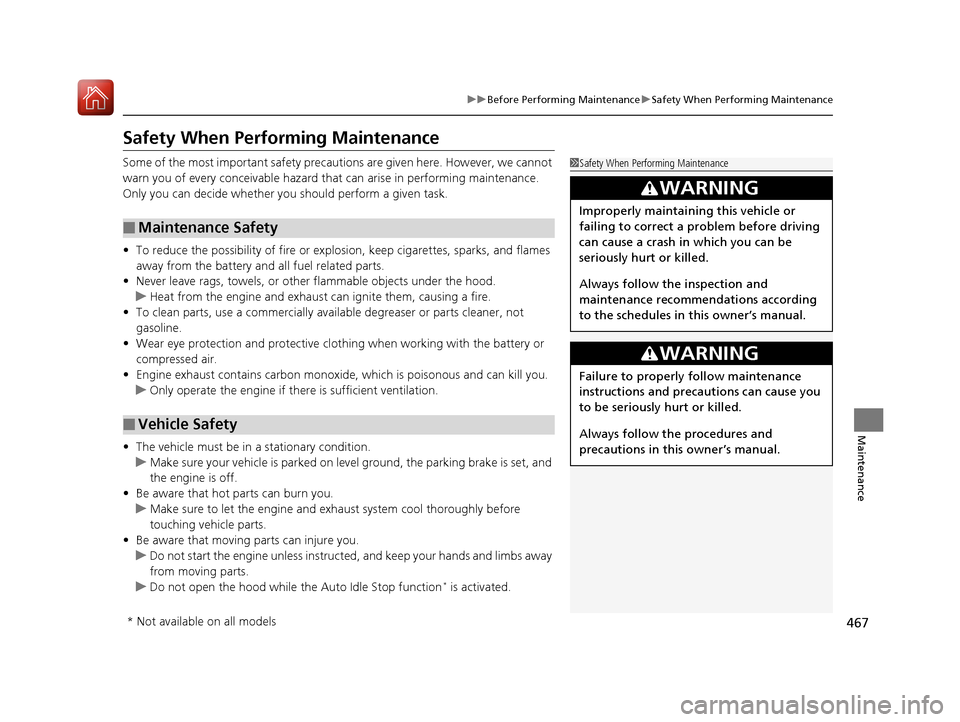
467
uuBefore Performing Maintenance uSafety When Performing Maintenance
Maintenance
Safety When Performing Maintenance
Some of the most important safety precau tions are given here. However, we cannot
warn you of every conceivable hazard that can arise in performing maintenance.
Only you can decide whether you should perform a given task.
• To reduce the possibility of fire or explos ion, keep cigarettes, sparks, and flames
away from the battery and all fuel related parts.
• Never leave rags, towels, or other flammable objects under the hood.
u Heat from the engine and exhaust can ignite them, causing a fire.
• To clean parts, use a co mmercially available degreas er or parts cleaner, not
gasoline.
• Wear eye protection and protective clothi ng when working with the battery or
compressed air.
• Engine exhaust contains carbon monoxide, which is poisonous and can kill you.
u Only operate the engine if th ere is sufficient ventilation.
• The vehicle must be in a stationary condition.
u Make sure your vehicle is parked on le vel ground, the parking brake is set, and
the engine is off.
• Be aware that hot parts can burn you.
u Make sure to let the engine and exhaust system cool thoroughly before
touching vehicle parts.
• Be aware that moving parts can injure you.
u Do not start the engine unless instruct ed, and keep your hands and limbs away
from moving parts.
u Do not open the hood while the Auto Idle Stop function
* is activated.
■Maintenance Safety
■Vehicle Safety
1Safety When Performing Maintenance
3WARNING
Improperly maintaining this vehicle or
failing to correct a pr oblem before driving
can cause a crash in which you can be
seriously hurt or killed.
Always follow the inspection and
maintenance recommendations according
to the schedules in this owner’s manual.
3WARNING
Failure to properly follow maintenance
instructions and precautions can cause you
to be seriously hurt or killed.
Always follow the procedures and
precautions in this owner’s manual.
* Not available on all models
20 ACURA TLX-31TZ36500.book 467 ページ 2019年2月7日 木曜日 午後2時2分
Page 479 of 589

478
uuMaintenance Under the Hood uOil Check
Maintenance
Oil Check
We recommend that you check the engi ne oil level every time you refuel.
Park the vehicle on level ground.
Wait approximately three minutes after turn ing the engine off before you check the
oil. 1.Remove the dipstick (orange).
2. Wipe the dipstick with a clean cloth or
paper towel.
3. Insert the dipstick back all the way into its
hole.
4-cylinder models
6-cylinder models
20 ACURA TLX-31TZ36500.book 478 ページ 2019年2月7日 木曜日 午後2時2分
Page 505 of 589
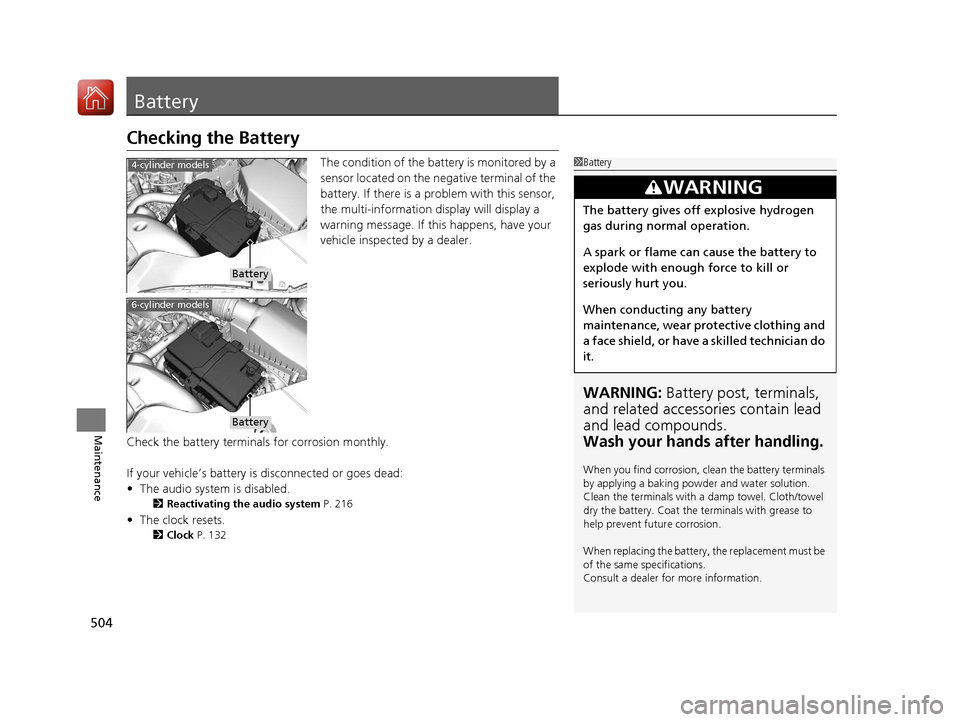
504
Maintenance
Battery
Checking the Battery
The condition of the battery is monitored by a
sensor located on the negative terminal of the
battery. If there is a problem with this sensor,
the multi-information display will display a
warning message. If this happens, have your
vehicle inspected by a dealer.
Check the battery termina ls for corrosion monthly.
If your vehicle’s battery is disconnected or goes dead:
• The audio system is disabled.
2 Reactivating the audio system P. 216
•The clock resets.
2 Clock P. 132
1Battery
WARNING: Battery post, terminals,
and related accessories contain lead
and lead compounds.
Wash your hands after handling.
When you find corrosion, cl ean the battery terminals
by applying a baking powder and water solution.
Clean the terminals with a damp towel. Cloth/towel
dry the battery. Coat the terminals with grease to
help prevent future corrosion.
When replacing the battery, the replacement must be
of the same specifications.
Consult a dealer for more information.
3WARNING
The battery gives off explosive hydrogen
gas during normal operation.
A spark or flame can cause the battery to
explode with enough force to kill or
seriously hurt you.
When conducting any battery
maintenance, wear prot ective clothing and
a face shield, or have a skilled technician do
it.
4-cylinder models
Battery
6-cylinder models
Battery
20 ACURA TLX-31TZ36500.book 504 ページ 2019年2月7日 木曜日 午後2時2分
Page 518 of 589
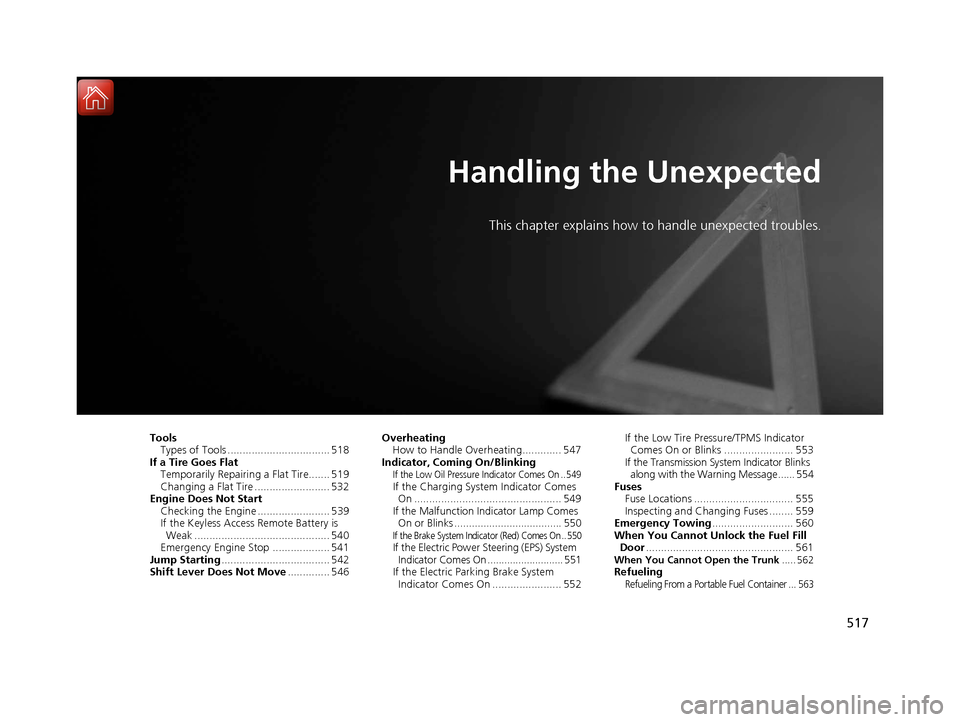
517
Handling the Unexpected
This chapter explains how to handle unexpected troubles.
ToolsTypes of Tools .................................. 518
If a Tire Goes Flat Temporarily Repairi ng a Flat Tire....... 519
Changing a Flat Tire ......................... 532
Engine Does Not Start Checking the Engine ........................ 539
If the Keyless Access Remote Battery is Weak ............................................. 540
Emergency Engine Stop ................... 541
Jump Starting .................................... 542
Shift Lever Does Not Move .............. 546Overheating
How to Handle Overheating............. 547
Indicator, Coming On/Blinking
If the Low Oil Pressure Indicator Comes On .. 549If the Charging System Indicator Comes On ................................................. 549
If the Malfunction Indicator Lamp Comes On or Blinks ..................................... 550
If the Brake System Indicator (Red) Comes On .. 550If the Electric Power Steering (EPS) System Indicator Comes On ........................... 551
If the Electric Parking Brake System Indicator Comes On ....................... 552 If the Low Tire Pressure/TPMS Indicator
Comes On or Blinks ....................... 553
If the Transmission System Indicator Blinks along with the Warning Message ...... 554
Fuses Fuse Locations ................................. 555
Inspecting and Changing Fuses ........ 559
Emergency Towing ........................... 560
When You Cannot Unlock the Fuel Fill Door ................................................. 561When You Cannot Open the Trunk ..... 562RefuelingRefueling From a Portable Fuel Container ... 563
20 ACURA TLX-31TZ36500.book 517 ページ 2019年2月7日 木曜日 午後2時2分
Page 519 of 589
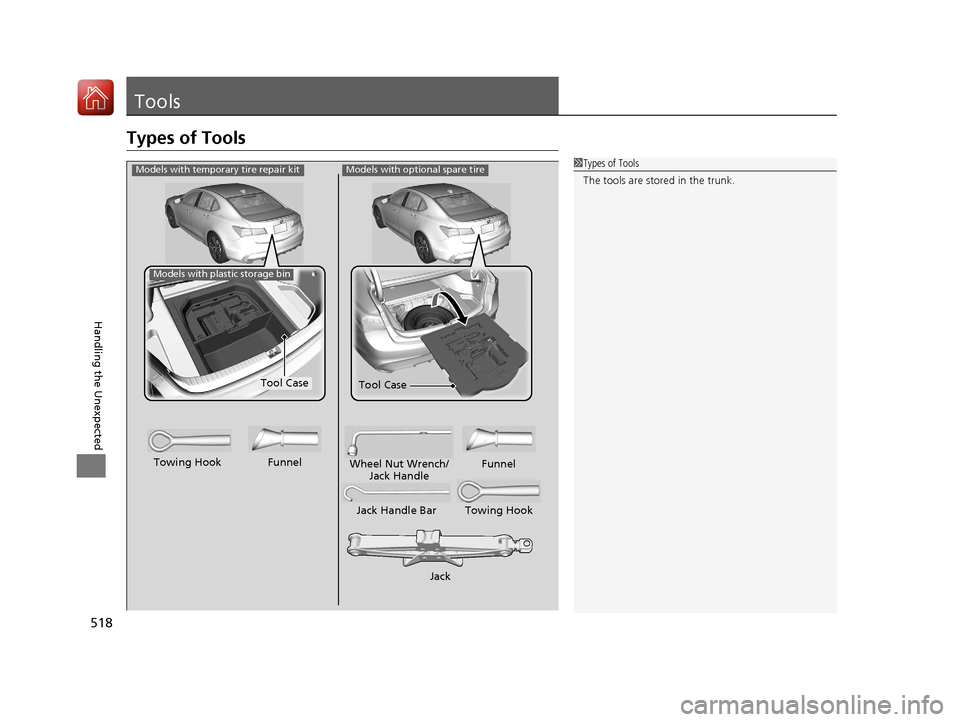
518
Handling the Unexpected
Tools
Types of Tools
1Types of Tools
The tools are stored in the trunk.Models with optional spare tire
Jack
Jack Handle Bar Towing Hook
Wheel Nut Wrench/
Jack Handle Funnel
Towing Hook Funnel
Models with temporary tire repair kit
Tool Case
Models with plastic storage bin
Tool Case
20 ACURA TLX-31TZ36500.book 518 ページ 2019年2月7日 木曜日 午後2時2分
Page 520 of 589
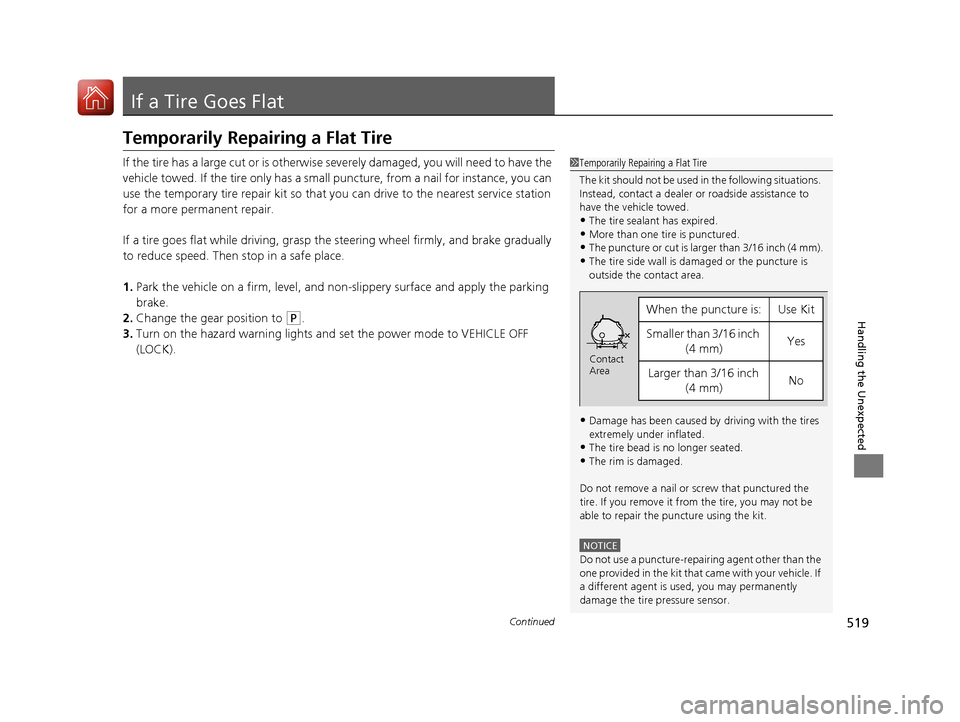
519Continued
Handling the Unexpected
If a Tire Goes Flat
Temporarily Repairing a Flat Tire
If the tire has a large cut or is otherwise severely damaged, you will need to have the
vehicle towed. If the tire only has a small puncture, from a nail for instance, you can
use the temporary tire repair kit so that you can drive to the nearest service station
for a more permanent repair.
If a tire goes flat while driving, grasp the steering wheel firmly, and brake gradually
to reduce speed. Then stop in a safe place.
1. Park the vehicle on a firm, level, and n on-slippery surface and apply the parking
brake.
2. Change the gear position to
(P.
3. Turn on the hazard warning lights an d set the power mode to VEHICLE OFF
(LOCK).
1 Temporarily Repairing a Flat Tire
The kit should not be used in the following situations.
Instead, contact a dealer or roadside assistance to
have the vehicle towed.
•The tire sealant has expired.
•More than one tire is punctured.•The puncture or cut is larger than 3/16 inch (4 mm).
•The tire side wall is da maged or the puncture is
outside the contact area.
•Damage has been caused by driving with the tires
extremely under inflated.
•The tire bead is no longer seated.
•The rim is damaged.
Do not remove a nail or screw that punctured the
tire. If you remove it from the tire, you may not be
able to repair the puncture using the kit.
NOTICE
Do not use a puncture-repairing agent other than the
one provided in the kit that came with your vehicle. If
a different agent is used, you may permanently
damage the tire pressure sensor.
When the puncture is:Use Kit
Smaller than 3/16 inch (4 mm)Yes
Larger than 3/16 inch (4 mm)No
Contact
Area
20 ACURA TLX-31TZ36500.book 519 ページ 2019年2月7日 木曜日 午後2時2分
Page 525 of 589

uuIf a Tire Goes Flat uTemporarily Repairing a Flat Tire
524
Handling the Unexpected
7. Press the inflator switch to turn on the
compressor.
u The compressor starts injecting sealant
and air into the tire.
u When the sealant injection is complete,
continue to add air.
8. After the air pressure reaches 32 psi (220
kPa), turn off the kit.
u To check the pressure , occasionally turn
off the compressor and read the gauge.
9. Unplug the power plug from the accessory
power socket.
10. Unscrew the sealant/air hose from the tire
valve stem. Reinstall the valve cap.
11. Press the pressure relief button until the
gauge returns to 0 psi (0 kPa).Pressure Gauge
ON
OFF
1Injecting Sealant and Air
If the required air pressure is not reached within 10
minutes, the tire may be too severely damaged for
the kit to provide the necessa ry seal, and your vehicle
will need to be towed.
See an Acura dealer for a replacement sealant bottle
and proper disposal of an empty bottle.
Sealant/Air Hose
Valve Stem
Pressure Relief Button
20 ACURA TLX-31TZ36500.book 524 ページ 2019年2月7日 木曜日 午後2時2分
Page 528 of 589

527
uuIf a Tire Goes Flat uTemporarily Repairing a Flat Tire
Continued
Handling the Unexpected
5. Turn the selector knob to AIR*1, AIR
ONLY*2, AIR SEULEMENT*2.
u Do not turn the air compressor on to
check the pressure.
2 Inflating an Under-inflated Tire P. 529
6.If the air pressure is
• Less than 25 psi (175 kPa):
Do not add air or continue driving. The
leak is too severe. Call for help and have
your vehicle towed.
2 Emergency Towing P. 560
•32 psi (220 kPa) or more:
Continue driving for another 10 minutes
or until you reach the nearest service
station, whichever is sooner. Do not
exceed 50 mph (80 km/h). If you have not
reached a service station, stop and check
the tire pressure.
u If the air pressure does not go down
after 10 minutes of driving, you do not
need to check the tire pressure again.
*1: U.S. models
*2: Canadian models
U.S.
Canada
20 ACURA TLX-31TZ36500.book 527 ページ 2019年2月7日 木曜日 午後2時2分
Page 529 of 589
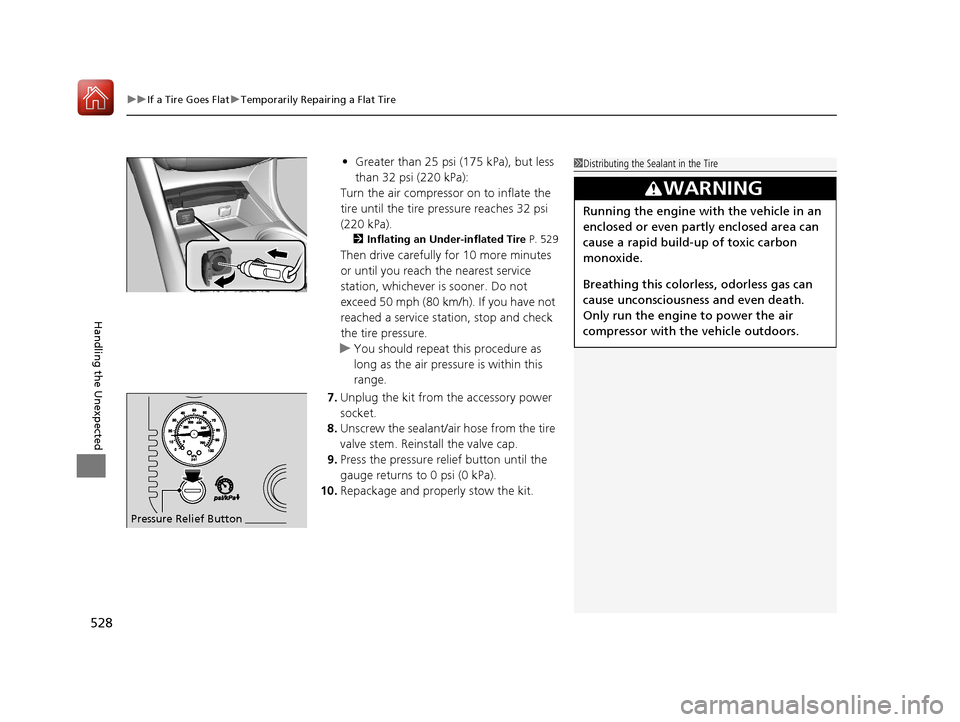
uuIf a Tire Goes Flat uTemporarily Repairing a Flat Tire
528
Handling the Unexpected
• Greater than 25 psi (175 kPa), but less
than 32 psi (220 kPa):
Turn the air compressor on to inflate the
tire until the tire pressure reaches 32 psi
(220 kPa).
2 Inflating an Under-inflated Tire P. 529
Then drive carefully for 10 more minutes
or until you reach the nearest service
station, whichever is sooner. Do not
exceed 50 mph (80 km/h). If you have not
reached a service station, stop and check
the tire pressure.
u You should repeat this procedure as
long as the air pressure is within this
range.
7. Unplug the kit from the accessory power
socket.
8. Unscrew the sealant/air hose from the tire
valve stem. Reinstall the valve cap.
9. Press the pressure relief button until the
gauge returns to 0 psi (0 kPa).
10. Repackage and proper ly stow the kit.
Pressure Relief Button
1Distributing the Sealant in the Tire
3WARNING
Running the engine with the vehicle in an
enclosed or even partly enclosed area can
cause a rapid build-up of toxic carbon
monoxide.
Breathing this colorless, odorless gas can
cause unconsciousness and even death.
Only run the engine to power the air
compressor with th e vehicle outdoors.
20 ACURA TLX-31TZ36500.book 528 ページ 2019年2月7日 木曜日 午後2時2分